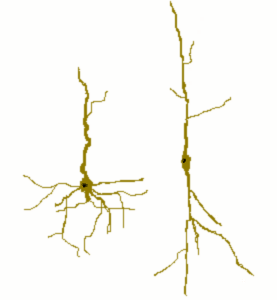Von Economo neuron
(Redirected from Spindle cells)
Type of neuron found in the brains of certain mammals
Von Economo Neurons[edit | edit source]
Von Economo neurons (VENs), also known as spindle neurons, are a specific type of neuron characterized by their distinctive spindle-shaped cell body. These neurons are primarily found in the anterior cingulate cortex and frontoinsular cortex of the brain in certain species, including humans, great apes, elephants, and cetaceans. They are named after the Austrian neurologist Constantin von Economo, who first described them in the early 20th century.
Structure[edit | edit source]
Von Economo neurons are notable for their elongated, spindle-like shape, which distinguishes them from other types of neurons. They have a large, elongated cell body with a single axon and a single dendrite extending from opposite ends. This unique morphology is thought to facilitate rapid communication across different regions of the brain.
Function[edit | edit source]
The exact function of Von Economo neurons is not fully understood, but they are believed to play a role in social cognition, decision-making, and the processing of complex emotional and social stimuli. Their presence in the anterior cingulate cortex and frontoinsular cortex suggests they may be involved in higher-order cognitive functions, such as empathy, self-awareness, and the regulation of social behavior.
Distribution[edit | edit source]
Von Economo neurons are found in a limited number of species, primarily those with large brains and complex social structures. In addition to humans, they have been identified in great apes, such as chimpanzees, gorillas, and orangutans, as well as in elephants and certain cetaceans, including whales and dolphins. This distribution suggests a possible link between the presence of VENs and advanced social behaviors.
Evolutionary Significance[edit | edit source]
The presence of Von Economo neurons in species with complex social systems has led researchers to hypothesize that these neurons may have evolved to support the demands of social living. Their unique structure and distribution suggest they may have developed to enhance communication and processing speed in large brains, facilitating the rapid exchange of information necessary for social interaction and decision-making.
Clinical Relevance[edit | edit source]
Research has suggested that abnormalities in Von Economo neurons may be associated with certain neurological and psychiatric conditions. For example, a reduction in the number of VENs has been observed in individuals with autism spectrum disorder and frontotemporal dementia. These findings indicate that VENs may play a critical role in the neural networks underlying social and emotional processing.
Related pages[edit | edit source]
Search WikiMD
Ad.Tired of being Overweight? Try W8MD's physician weight loss program.
Semaglutide (Ozempic / Wegovy and Tirzepatide (Mounjaro / Zepbound) available.
Advertise on WikiMD
|
WikiMD's Wellness Encyclopedia |
| Let Food Be Thy Medicine Medicine Thy Food - Hippocrates |
Translate this page: - East Asian
中文,
日本,
한국어,
South Asian
हिन्दी,
தமிழ்,
తెలుగు,
Urdu,
ಕನ್ನಡ,
Southeast Asian
Indonesian,
Vietnamese,
Thai,
မြန်မာဘာသာ,
বাংলা
European
español,
Deutsch,
français,
Greek,
português do Brasil,
polski,
română,
русский,
Nederlands,
norsk,
svenska,
suomi,
Italian
Middle Eastern & African
عربى,
Turkish,
Persian,
Hebrew,
Afrikaans,
isiZulu,
Kiswahili,
Other
Bulgarian,
Hungarian,
Czech,
Swedish,
മലയാളം,
मराठी,
ਪੰਜਾਬੀ,
ગુજરાતી,
Portuguese,
Ukrainian
Medical Disclaimer: WikiMD is not a substitute for professional medical advice. The information on WikiMD is provided as an information resource only, may be incorrect, outdated or misleading, and is not to be used or relied on for any diagnostic or treatment purposes. Please consult your health care provider before making any healthcare decisions or for guidance about a specific medical condition. WikiMD expressly disclaims responsibility, and shall have no liability, for any damages, loss, injury, or liability whatsoever suffered as a result of your reliance on the information contained in this site. By visiting this site you agree to the foregoing terms and conditions, which may from time to time be changed or supplemented by WikiMD. If you do not agree to the foregoing terms and conditions, you should not enter or use this site. See full disclaimer.
Credits:Most images are courtesy of Wikimedia commons, and templates, categories Wikipedia, licensed under CC BY SA or similar.
Contributors: Prab R. Tumpati, MD


